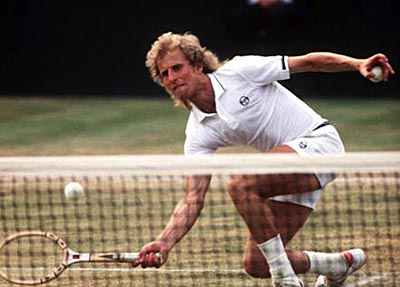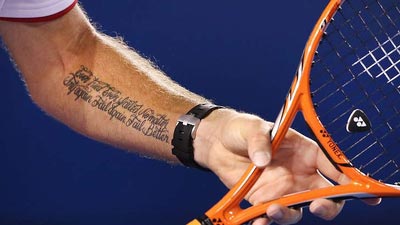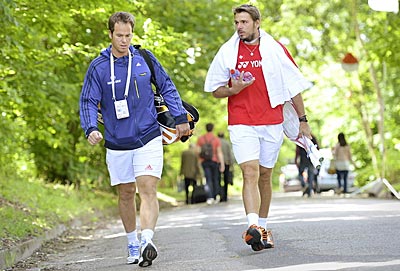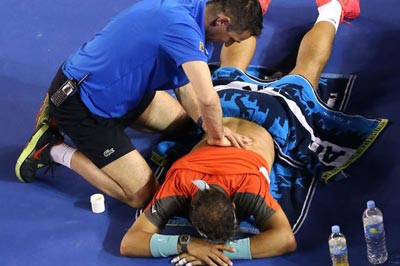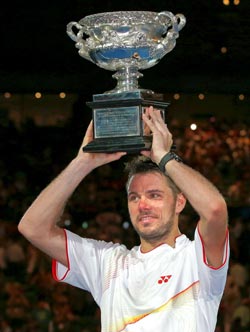|
TennisOne Lessons Anatomy of An Upset at the Australian Open Paul Fein "No one beats Vitas Gerulaitis 17 straight times!" quipped colorful Gerulaitis in 1979 when he finally beat Jimmy Connors after 16 straight defeats. That famously funny quote will long be remembered by tennis aficionados. Gerulaitis uttered a more important quote for tournament players, though, when his losing streak against Bjorn Borg, another nemesis, also reached 16 matches: "I've never had a negative attitude even while losing to him sixteen times in a row."
Entering the 2014 Australian Open, Stanislas Wawrinka, like Gerulaitis, was enduring monster losing streaks to the top two players in the world. He stood 0-12 against No. 1 Rafael Nadal and 0-14 against No. 2 Novak Djokovic. On the plus side, Wawrinka had just completed his best year by far. He extended Djokovic to grueling five-setters at the Australian and US Opens, pushed Nadal to two tiebreakers at the ATP Finals, notched nine wins over top 10 players (second only to Nadal and Djokovic), and achieved a career-high No. 8 ranking. Not only had Wawrinka never beaten Nadal or Djokovic anywhere, but no player, including the legendary Roger Federer, had ever beaten the Big Two in the same Grand Slam event. That was Wawrinka's seemingly mission impossible. Perhaps visiting the Melbourne museum devoted to his fictional hero James Bond before the final inspired him to accomplish it. Much like the 2013 Wimbledon, this Australian Open was highlighted by stunning upsets and career breakthroughs that are both instructive and inspirational. Here are four lessons you can learn from how Wawrinka conjured up his biggest upset. Have a Positive Attitude Wawrinka was so intent on doing exactly this and forever reminding himself of it that he had tattooed on his left forearm a motivational Samuel Beckett quote: "Ever tried. Ever failed. No matter. Try again. Fail again. Fail better." After upsetting Nadal in the Australian final, Wawrinka explained: "I had that quote in my head for a long time. It was part of my life, how I see life, especially how I see my tennis life. Before today, I always was saying that against Roger, Rafa, Novak, you always lose, every week. So, it's not easy, my tennis life. When you lose, it's tough to get through, to take a positive from a loss, failing again at a tournament."
All those losses had taken their toll, and after losing to the clay-court maestro Nadal in the 2013 Madrid final, Wawrinka conceded: "He killed me. Unless you are 100 percent physically and mentally, you do not have a chance." In interviews during the past 12 months, however, the 28-year-old Swiss increasingly accentuated the positive. He often noted his brilliantly played but heartbreaking loss to Djokovic at the 2013 Australian Open transformed his career because it gave him the belief he could compete with, and even beat, the elite. A year later, Wawrinka's inferiority complex was gone. After beating Tomáš Berdych in four sets to reach his first Grand Slam final in Melbourne, Wawrinka, pleased with his progress, said, "I'm at the top of my career. Already last year I had the feeling that I was playing better, but I was dealing better with the pressure also. I'm more mature. I'm 28 now. I'm on the tour since the last 10 years. Now I feel that it's my time to play my best tennis." Despite the heavy 1-6 odds bookmakers gave Nadal to win the final, Severin Luthi, the Swiss Davis Cup captain, pointed out the importance of Wawrinka's growing confidence and momentum. "Psychologically, he broke a long losing streak against Novak and he can do the same with Rafa in the final," he rightly predicted in The Times (UK). Wawrinka's 6-3, 6-2, 3-6, 6-3 victory, even considering Nadal's back injury, completed his long evolution from contender to champion. Get Physical Federer, his friend and confidant, calls Wawrinka "Stanimal" because he boasts a rugged Nadal-like physique and plays relentless power tennis. "We've seen how much Stan's body has changed since 2009," says ESPN analyst and former Australian Davis Cupper Darren Cahill. "He's really turned himself into a physical beast on the court. That's the way he's based his game now. He can play six feet behind the baseline. He has that power off both wings, and he does a lot of damage even from there." Some of Wawrinka's forehand winners exceeded 100 mph (161 kmh)!
Wawrinka's tremendous upper-body strength enables him to use a platform stance and generate great racket-head speed on his serve with a simple, balanced motion. "It's amazing the power Wawrinka has in his serve without using his legs and only bending his knees a little," noted Cahill. As a result, his first serve averaged 192 kmh (119.3 mph), and produced 19 aces and only two double faults against Nadal. Tellingly, he delivered his fastest first serves in the final set, averaging 204 kmh (126.8 mph). Overall, he blasted an outstanding 53 winners. His numbers were remarkably consistent against both formidable serve returner Djokovic (187 kmh, 7 aces, 1 double fault, 45 winners) in the quarters, and Berdych (189 kmh, 18, 4, 53) in the semis. Finally, that bull-like strength, combined with impeccable stroke and footwork technique, gave his backhand substantial power for a one-hander. Devise a Smart Game Plan Though his serve and backhand have more power, and his defense is inferior,Wawrinka’s game resembles Federer’s in key respects. He learned from Federer’s matches what works and what doesn’t work against Nadal. Federer also shared his insights and offered advice to his countryman during an hour conversation before the final. Finally, Wawrinka’s new coach, Magnus Norman, the 2001 French Open runner-up and the mastermind of Robin Soderling’s shocking upset over Nadal at the 2009 French Open, created the clever tactics that would confound Nadal.
The first tactic was mental. "I talk a lot with Magnus, who has been in that situation, to play a final," Wawrinka said. "He told me it was important not to think about the result but think about the way you want to play, the way you want to win every point." To win, Wawrinka had to play the match on his terms, not Nadal’s. He couldn’t allow Nadal to break him down physically and mentally with long, grinding points in which the punishing Nadal forehand, the most devastating groundstroke in tennis history, dictated the vast majority of rallies. But how best to do that? As a result, Nadal hit far fewer forehands than in earlier matches. Unable or unwilling to hit down-the-line backhands, Nadal was forced to hit many backhands crosscourt to Wawrinka's dominating forehand. Tennis Channel analyst Justin Gimelstob called Wawrinka's aggressive, accurate, topspin forehand "one of the most improved shots in tennis. What was a good shot has become a great shot." Strangely, the tactically befuddled Nadal directed far too many of his forehands to Wawrinka's significantly stronger forehand side (much like Serena Williams in her upset loss to Ana Ivanovic) which produced 19 winners and caused 11 forced errors.
Nadal thrives on rhythm and predictability. So Wawrinka put him off balance and out of his groove with the third tactic. Inside-out forehands and crosscourt backhands to Nadal’s forehand created openings on his backhand side, which worked well particularly because Nadal leans and positions himself toward the forehand side. When Nadal scrambled to reach those well-placed forehands, Wawrinka countered with effective, sometimes point-winning backhands down the line into the open court. The plan worked. Nadal committed 20 of his 31 forced groundstroke errors on his backhand. The fourth tactic, serving and volleying, further confused and frustrated Nadal because he returns serve so far (usually 10 feet) behind the baseline and his slice backhand is particularly vulnerable against slice serves in the deuce court. Wawrinka won five of six (83%) serve-volley points. Although he didn’t approach net that often, partly because he blasted so many groundstroke winners, he won 11 of 12 points there. Even more impressive, Wawrinka won 46 of 53 of his first serve points, a terrific 87%, which largely explains why he lost his serve only twice in 18 service games. Adapt to the Unexpected
Even the best-laid game plans can go awry. In this case, Wawrinka couldn’t have anticipated Nadal would suffer a back injury that would worsen after the first set and require a seven-minute medical time-out. The Swiss didn’t handle it as well as he could have in two respects. For five minutes when the trainer attended to Nadal, Wawrinka barked at chair umpire Carlos Ramos about Nadal’s leaving the court, when he should have relaxed and exercised to stay flexible and warm. When play resumed at 6-3, 2-1, Wawrinka kept his momentum to hold serve at love. Then he easily broke serve at 15 for 4-1, and held serve with two aces and a forehand winner to close out the set, 6-2. The third set found the determined, but impaired Nadal—who calls the Aussie Open his “unlucky Slam”—still barely able to serve 90 mph and unable to run at full speed. Yet Wawrinka suddenly and strangely became inept, making a shocking 19 unforced errors. What happened? “I didn’t play well because I was waiting for him to miss,” Wawrinka explained. “And that was a big mistake. Because I was nervous, I was like ‘OK, miss. Miss. Make a mistake because I’m not going to win the match because I’m nervous.”
As Gimelstob pointed out, “One of the tougher things in sports is to play a wounded opponent.” Wounded tiger Nadal was especially tough because he became unpredictable. On Wawrinka’s predicament, Tennis Channel analyst Martina Navratilova explained, “You try to play the same way, but you really can’t because your opponent is not playing the same shots to you. Nadal’s first serve is coming 80 miles per hour. His groundstrokes are either no pace or a flat ball that’s hard and completely different. And at the same time, you don’t want to miss. But when you play not to miss, you start missing more. Now Wawrinka has no rhythm.” Fortunately, Wawrinka regained his poise, focus, and rhythm in the fourth set. Reversing Nadal’s momentum, he bulled the Spanish matador around the court again with aggressive shots, and sharply reduced his unforced errors. He made a statement by winning the opening game at love, broke the still competitive Nadal’s serve twice, and finally finished him off with a forehand winner to seize the championship game at love. We’ll never know how Wawrinka would have fared against an uninjured Nadal. But based on his superlative performance up to 6-3, 2-1, when Nadal was unimpeded, “Stanimal” would certainly be favored. This triumph was no fluke. The long wait for a new star to challenge Nadal, Djokovic, and Murray is over. Stan is The Man. It’s easy to agree with Navratilova’s prediction: “I do not see Wawrinka as a one-Slam wonder.” Your comments are welcome. Let us know what you think about Paul Fein's article by emailing us here at TennisOne.
Paul Fein Paul Fein has received more than 30 writing awards and authored three books, Tennis Confidential: Today’s Greatest Players, Matches, and Controversies, You Can Quote Me on That: Greatest Tennis Quips, Insights, and Zingers, and Tennis Confidential II: More of Today’s Greatest Players, Matches, and Controversies. Fein is also a USPTA-certified teaching pro and coach with a Pro-1 rating, former director of the Springfield (Mass.) Satellite Tournament, a former top 10-ranked men’s open New England tournament player, and formerly a No. 1-ranked Super Senior player in New England. |
